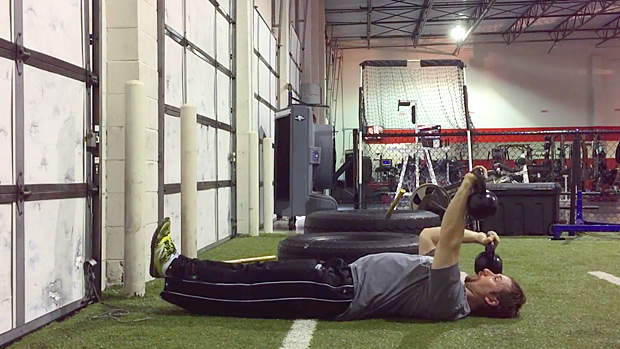Big Ups
I get asked a lot of questions from trainees. Here are the four most frequent:
- How can I improve my bench?
- How can I lose fat while gaining muscle?
- How can I improve my vertical jump?
- Coach, why does it burn when I pee?
Okay, I'm kidding about that last one, but the first few really are the "big three" of all training questions! I've covered the first two in past Testosterone Nation articles, so today I'm going to tackle the third: how to increase your "ups."
There are several things to consider when designing a program aimed at improving your vertical:
1 Exercise Selection
You want to pick the exercises which will be the most helpful in improving your jumping capacity. These are:
- Back squat
- Jump squat
- Jump lunges (or jump split squat)
- Romanian deadlift
- Olympic lift variations (power clean from hang or power snatch from hang or blocks)
- Depth jumps
- Vertical jumps
- Bulgarian squat
2 Physical Capacities Required
When it comes to jumping high, the two most important qualities are strength and power (speed-strength). The need for power is self-evident, but few understand that strength is also an important key. Strength is the basis on which power is built. Without a fair amount of strength, power can't be increased by much as you'll always be limited by your muscles' capacity to produce force.
3 Training Parameters
Now that we know which capacities need to be developed, we can select the proper training zones. These are: relative strength, limit strength, speed-strength, and strength-speed. These zones are characterised by the following parameters:
- Relative Strength
- Reps per set: 1-3
- Load: 90-100%
- Type of exercises: Basic compound movements
- Limit Strength
- Reps per set: 4-6
- Load: 85-90%
- Type of exercises: Basic compound movements
- Speed-Strength
- Reps per set: 8-10
- Load: Body weight (plyometric) or 10-30% (ballistic movements)
- Type of exercises: Plyo and ballistic exercises
- Strength-Speed
- Reps per set: 3-5
- Load: 45-55 (regular lifts) or 70-80% (Olympic lift variations)
- Type of exercises: Basic compound movements and Olympic variations
4 Training Frequency
The lower body should be trained twice per week, which is optimal to develop the capacities without causing excessive fatigue or recovery debt. The upper body is also trained twice per week; one session is for basic strength lifts while the second one is more for auxiliary exercises (easier workout).
5 Type of Contraction
It goes without saying that explosive exercises are necessary for the development of jumping capacity. However, you shouldn't neglect the importance of isometric and eccentric strength in jumping capacity.
Jumps involve a pre-stretch/eccentric phase and a transition phase (isometric phase just before the switch from eccentric to explosive concentric). Without proper eccentric strength, you can't make maximal use of the pre-strength phase of a jump. And without proper isometric strength, the switch from eccentric to explosion will be slower, thus decreasing jumping power.
Here's a six week plan to get your ups up. If you follow it to a "T" you'll undoubtedly increase not only your vertical jump, but also your running speed and lower body strength!
Day 1
- A. Back Squat
- Weeks 1-3: 4 x 4-6 reps
- Weeks 4-6: 5 x 1-3 reps
- B. Romanian Deadlift
- Weeks 1-3: 4 x 4-6 reps
- Weeks 4-6: 5 x 1-3 reps
- C. Speed Squat
- Weeks 1-3: 5 x 2 @ 45% (45 sec. rest)
- Weeks 4-6: 5 x 2 @ 55% (60 sec. rest)
- D. Jump Squat
- Weeks 1-3: 3 x 8-10 @ 20% bodyweight
- Weeks 4-6: 3 x 8-10 @ 30% bodyweight
As the name implies, go light and jump at the top of the movement! - E. Vertical Jump
- Weeks 1-3: 3 x 8-10
- Weeks 4-6: 3 x 8-10
Day 2
- A. Bench Press
- Weeks 1-3: 4 x 6-8
- Weeks 4-6: 5 x 4-6
- B. Bentover Barbell Rowing
- Weeks 1-3: 4 x 6-8
- Weeks 4-6: 5 x 4-6
- C. Push Press
- Weeks 1-3: 4 x 6-8
- Weeks 4-6: 5 x 4-6
- D. Weighted Chin-Up
- Weeks 1-3: 4 x 6-8
- Weeks 4-6: 5 x 4-6
Day 3
- A. Depth Jump
- Weeks 1-3: 3 x 8-10 (50cm box)
- Weeks 4-6: 3 x 8-10 (70cm box)
- B. Jump Split Squat
- Weeks 1-3: 3 x 4-5/side (hold a dumbbell that's 10% of your bodyweight)
- Weeks 4-6: 3 x 4-5/side (hold a dumbbell that's 20% of your bodyweight)
- C. Power Clean from Blocks
- Weeks 1-3: 4 x 3-5 reps
- Weeks 4-6: 5 x 1-3 reps
- D. Bulgarian Squat Iso-Contrast
- Weeks 1-3: 3 x 4-5/side (5 sec. isometric pause when the knee is at 90 degrees)
- Weeks 4-6: 3 x 4-5/side (7 sec. isometric pause when the knee is at 90 degrees)
- E. Top Squat, Overcoming Isometrics
- Weeks 1-3: Press against pins, 3 sets of 5 reps of 6 sec. each (3 sec. pause between reps)
- Weeks 4-6: Press against pins, 4 sets of 5 reps of 3 sec. each (3 sec. pause between reps)
Day 4
- A. Incline Press
- Weeks 1-3: 4 x 10-12
- Weeks 4-6: 4 x 8-10
- B. Incline Dumbbell Rowing
- Weeks 1-3: 4 x 10-12
- Weeks 4-6: 4 x 8-10
- C. Close-Grip Bench Press
- Weeks 1-3: 4 x 10-12
Weeks 1-3: 4 x 10-12 - Weeks 4-6: 4 x 8-10
- D. Barbell Curl
- Weeks 1-3: 4 x 10-12
- Weeks 4-6: 4 x 8-10
- E. Decline Dumbbell Triceps Extension
- Weeks 1-3: 4 x 10-12
- Weeks 4-6: 4 x 8-10
- F. 2/1 Machine Curl
- Weeks 1-3: 3 x 4-5/side (lift explosively with 2 arms, lower in 5 sec. with 1 arm)
- Weeks 4-6: 3 x 4-5/side (lift explosively with 2 arms, lower in 5 sec. with 1 arm)
This program should yield impressive gains in vertical jump capacity, as well as in lateral agility and sprinting speed. It would also allow you to maintain or even increase your muscle mass, especially if a proper muscle-gaining nutrition program and the right supplements are used.
I strongly suggest using Biotest's neural boosters Spike® and Brain Candy® alternatively on the lower body workouts. Plazma™ should be used with all the workouts.
If speed and power are what you're looking for, this is the plan for you!





